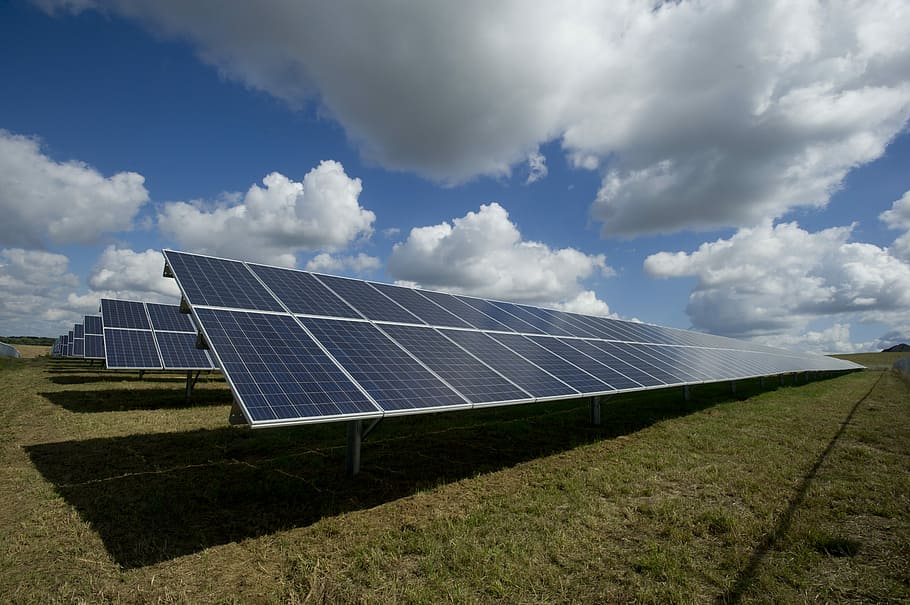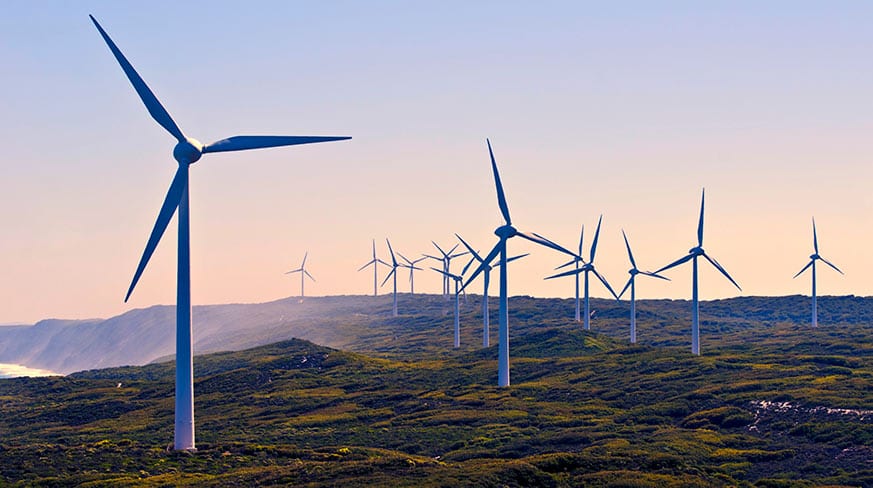 In July of this year a $22 billion proposal by Sun Cable Pty Ltd, a company which is backed by by two Australia billionaires Fortesque Metals founder Andrew Forrest and and Atlassian co-founder (with Scot Farquhar) Mike Cannon-Brookes was granted ‘major project status’ by the Australian Government to investigate the building in the Northern Territory of a massive 10-gigawatt solar farm (40 million panels) coupled to a 30Gwh storage facility, which I presume means a big battery.
In July of this year a $22 billion proposal by Sun Cable Pty Ltd, a company which is backed by by two Australia billionaires Fortesque Metals founder Andrew Forrest and and Atlassian co-founder (with Scot Farquhar) Mike Cannon-Brookes was granted ‘major project status’ by the Australian Government to investigate the building in the Northern Territory of a massive 10-gigawatt solar farm (40 million panels) coupled to a 30Gwh storage facility, which I presume means a big battery.

The plan is to export the power generated by the solar farm in Tennant Creek in the Northern Territory to Darwin and then 3,700 kilometres via an under sea cable to Singapore. The power generated by what is claimed to be the biggest solar farm in the world will be sufficient to supply all of Darwin’s power needs and 30% of Singapore’s and, say the proposers, lessen Singapore’s reliance on imported gas, which currently supplies over 95% of their power needs.
Singapore has no natural resources and little available land.
At present Singapore receives 71% of the natural gas it requires from Indonesia and Malaysia by pipeline and the rest it imports as LNG from a range of countries. One natural gas pipeline from Indonesia is scheduled to close in 2023 and others from Indonesia and Malaysia are constantly under review as domestic consumption increases in both counties.

In March 2020 Singapore household consumers paid $0.27 kWh for electricity and in Australia, on average, consumers paid $0.37 kWh. Understandably Singaporean authorities have been reluctant to comment on the proposal and others have expressed concerns regarding the security of the supply, which is understandable considering that the Northern Territory is frequently visited by cyclones and monsoonal storms. The other question is whether a marine cable would be secure from interference?

It is well known in business circles and carefully ignored in all political circles in Australia, that one of the main reasons we have exported our manufacturing industries and so jobs and skills to other countries, mainly to China, is because the price of electricity in Australia is one of the most expensive in the world.
Australia – Biggest spenders in the world on renewables.
 It can be argued that in becoming the country that has spent 10 times more per capita on renewable energy than any other country in the world, the price Australia has paid is the loss of the heart of its manufacturing industries — an examination of product labels showing where products are made in Bunnings, Target, K Mart, Office Works and any specialist tool shop or furniture shop (the latest being the great Australian Koala who are moving mattress manufacture to China) will convince the sceptic that our reliance on China, from whom we import goods worth about $6 billion a month, has made us vulnerable to day to day tensions in trade and wolf warrior diplomacy from China — the latest being a reported slowdown with coal exports.
It can be argued that in becoming the country that has spent 10 times more per capita on renewable energy than any other country in the world, the price Australia has paid is the loss of the heart of its manufacturing industries — an examination of product labels showing where products are made in Bunnings, Target, K Mart, Office Works and any specialist tool shop or furniture shop (the latest being the great Australian Koala who are moving mattress manufacture to China) will convince the sceptic that our reliance on China, from whom we import goods worth about $6 billion a month, has made us vulnerable to day to day tensions in trade and wolf warrior diplomacy from China — the latest being a reported slowdown with coal exports.
There is no doubt that over the last twenty years successive Australian governments have sacrificed much of Australia’s independence and manufacturing self-reliance and skills to the all powerful Left/Green hysterical paranoia and manic fear of being judged by great imagined political power behind the god of climate change and so losing political power in the process.
The result in Figure 1 is graphic and worrying and testament to a nation being taken the wrong way — Australia is now paying the price for politicians being climate righteous, more ‘Holy than Thou’ while the rest of the world watched and Australian firms took their manufacturing to other countries.
Perversely Australia subsidises the renewable energy industry with $2.8 billion every year, much of it going to overseas investors, and reports claim this will continue to 2030 to help Australia reach its renewable energy target to comply with the Paris Accord. That is $28 billion in 10 years and $56 billion over 20 years to prop up an industry that is currently supplying just 24% of Australia’s power needs.
Can Australia run on renewables alone? In 2010 the Government claimed that it could by 2020 at the cost of some $370 billion. In 2011 the governments position had changed to 50% of base load power was achievable from renewables by 2040. Now in 2020 we have Minister Taylor’s plans for the production of Australia’s energy needs in the future, and although there is no mention of 100% renewables, there is a lot of talk about gas as the transition fuel to a bigger renewable future. If the government changes at the next election we will no doubt have another agenda and target.
The Price of Power.

Singapore consumers currently pay less for their electricity than consumers in Australia, and that is in a country that has no natural resources of its own and that currently imports 100% of the gas it requires for power generation. In Australia we have an abundance of gas and we pay more for our power than those who buy our gas — make things, something we have forgotten over the last decade or three.
What is it that motivates people like Cannon-Brookes and Forrest to back a plan to export electricity from Australia to Singapore? The first answer that most would come up with is money —they are already billionaires, but they want more.
Brookes-Taylor is a strong advocate for renewable energy and regularly appears on TV with other renewable energy luvvies and quite often criticises the federal government’s energy policy. But Cannon-Brookes is not and advocate for paying Australian tax, because both he and Atlassian don’t pay any tax in Australia.
In 2014, Cannon-Brookes and Scott Farquhar embarked upon a highly complex London-based structure that enables the arbitrage of global tax codes and ensures their tech darling will pay very little tax for a very long time. (AFR Feb 23 2020)
Andrew Forrest has his fingers in many pies from cattle stations to abattoirs to oyster farms and is a philanthropist extraordinaire. He and his wife have donated many hundreds of millions to various causes many of which he controls. He is ridiculously rich and giving it away, to himself, reduces his taxes. It is also obvious that he has an agenda, how this agenda fits in with the Sun Cable project is somewhat nebulous.
So I think there is nothing altruistic in the motives of either Forrest or Cannon-Brookes, I think they are both in it for the money, they both minimise or don’t pay tax in Australia and if they can get cash some off the Australian taxpayer in the form of a subsidy for the Sun Cable project then that is cream on their cake – its a win-win for them. Can you believe this stuff?
WHY SINGAPORE?
But that still doesn’t answer the question why Singapore? Why Singapore when the stated aim of many in Australia, including the vocal Cannon-Brookes is for the phasing out of fossil fuel fired power stations in Australia, which currently supply 79% of Australia’s power.
If that is the objective of these save the planet with renewable energy warriors, and it is because they have said so on many occasions, then why isn’t this project for the biggest solar farm and probably the biggest battery in the world directed towards supplying Australia with the power it requires to meet its renewable energy targets?
When you look at the projected costs of the solar farm, cable and battery storage to supply power Singapore it comes $8 billion less than the amount ($28 billion) Australian taxpayers will fork out in subsidies to the renewable energy industry over the next decade. Make sense of that if you can?


Roger
1. The price of power had little to do with the closure of manufacturing in Australia I ran manufacturing businesses in Australia for many years and mostly electricity cost was less than 2% of sales.
Our three biggest difficulties were scale, freight and a fluctuating currency. After I sold my businees I designed machines for a larger Italian competitor. Their purchases were 30% lower cost than mine, a) because they bought 2-3 times as much, b) because they did not have to pay freight and nuisance duties to Australia and at least one extra distributer in the chain and c) freight back to most of their markets.
Total energy bills as a share of sales in Italy were the same or higher than they are here yet Italy’s exports of manufactured goods are more than all Australia’s exports combined.
If power was a big driver how come we produce more Aluminium than the US, France, the UK, Spain and Germany, all of whom have much higher demand for Aluminium than us.
2. As Singapore doesn’t have ticket clippers at every turn and is a high density market its transmission, distribution and retailing costs are probably less than half ours. It is also still running off old gas contracts which may have been struck at 1/5th of less than current prices. That is why its power is cheaper.
However at the margin Singapore gets gas from the LNG market and that share is likely to increase as nearby Malaysian and Indonesian fields decline. At current LNG prices that results in power costs at the generator of $110/MWh. As Sun cable is only proposing to supply 15% of Singapores electricity LNG will be the market it is targeting
3. a) Re vulnerability, the picture you show is of a solar farm that was built to withstand category 3 hurricanes because that was the strongest recorded storm in the region. Then it was hit by a category 5 storm. New solar farms have been built in the same region now with Cat 5 design standards and they have been replaced quicker than destroyed gas plants.
b) I would imagine that one of the reasons that the farm is proposed at Elliot is that cyclones rarely maintain highest wind speeds for more than 100km inland. As Sun Cable is 650km inland it is extremely unlikely to see category 1 winds let alone category 5.
c) Elliot has 34 cloudy days a year, i.e. very high solar yield much higher than Darwin with 134 cloudy days
4. Based on costs in the North Sea an even more hostile environment for underwater cable laying the transmission and storage component will be about $10bn of the total $22bn budget. If the project produces 23 million MWh per year and has interest, depreciation, operation, administration and maintence costs of A$2.8bn per year, that is a cost delivered of <US$90.
To me that is marginal but if Singapore decides it is obliged to apply a carbon price of US$40/ tonne it is a no brainer
I remain convinced that Forrest and Cannon Brooks remain first in their plans and Australia runs a poor second.